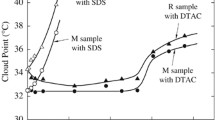Abstract
Cationic amphiphilic polymers (e.g. polyvinylpyridinium bromides and polyvinylimidazolium bromides) adopt a compact coiled form in aqueous solutions. In the case of former polymers, the resulting hydrophobic microdomains are evidenced only by fluorescence spectroscopy if a molecular rotor (DMAC) is used as a fluorescent probe, while the behaviour of the latter can be studied in aqueous solution by using both types of fluorescent probes, i.e., pyrene and the molecular rotor. The purpose of the present investigation deals with a comparative study between the magnitude of the local viscosity and the polarity of the hydrophobic microdomains generated by poly(3-hexadecyl-1-vinylimidazolium bromide) in an aqueous medium using pyrene and DMAC as fluorescent probes. Moreover, the results are compared with the data obtained with micelles of conventional surfactants such as the homopolymer repetitive unit model and CTAB.
Similar content being viewed by others
References
Berger DR (1990) In: Richmond JM (ed) Cationic Surfactants. Surfactants Science series vol. 34. Marcel Dekker, New York, pp 243–273
Wessling RA, Pickelman DM (1981) J Dispers Sci Technol 2: 281
Binana-Limbele W, Zana R (1987) Macromolecules 20: 1331
Damas C, Brembilla A, Lochon P, Baros F, Viriot ML (1994) Eur Polym J 30: 1215
Benjelloun A, Brembilla A, Lochon P, Adibnejad M, Viriot ML, Carré MC (1996) Polymer 37: 879
Benjelloun A, Damas C, Brembilla A, Lochon P (1994) Polym Bull 33: 513
Matsuoka M, Takao M, Kitao T, Fujiwara T, Nakatsu K (1990) Mol Cryst Liq Cryst 182 A: 71
Duynstee EF, Grunwald E (1959) J Am Chem Soc 81: 4540
Reichardt C (1988) In: Ebel HF (ed) Solvents and Solvents Effects in Organic Chemistry, 2nd Edn, VCH, Weinheim, pp 365–371
Winnik FM (1993) Chem Rev 93: 587
Dong DC, Winnik MA (1984) Can J Chem 62: 2560
Berthod A (1983) J Chim Phys-Phys Chim Biol 80: 407
André B, Boyer B, Lamaty G, Roque JP (1991) Tetrahedron Lett 32: 1881
Loufty RO, Arnold BA (1982) J Phys Chem 86: 4205
Hayashi R, Tazuke S, Frank CW (1987) Macromolecules 20: 983
Paczkowski J (1991) Macromolecules 24: 2172
Author information
Authors and Affiliations
Rights and permissions
About this article
Cite this article
Damas, C., Adibnejad, M., Benjelloun, A. et al. Fluorescent probes for detection of amphiphilic polymer hydrophobic microdomains: A comparative study between pyrene and molecular rotors. Colloid Polym Sci 275, 364–371 (1997). https://doi.org/10.1007/s003960050093
Received:
Accepted:
Issue Date:
DOI: https://doi.org/10.1007/s003960050093




